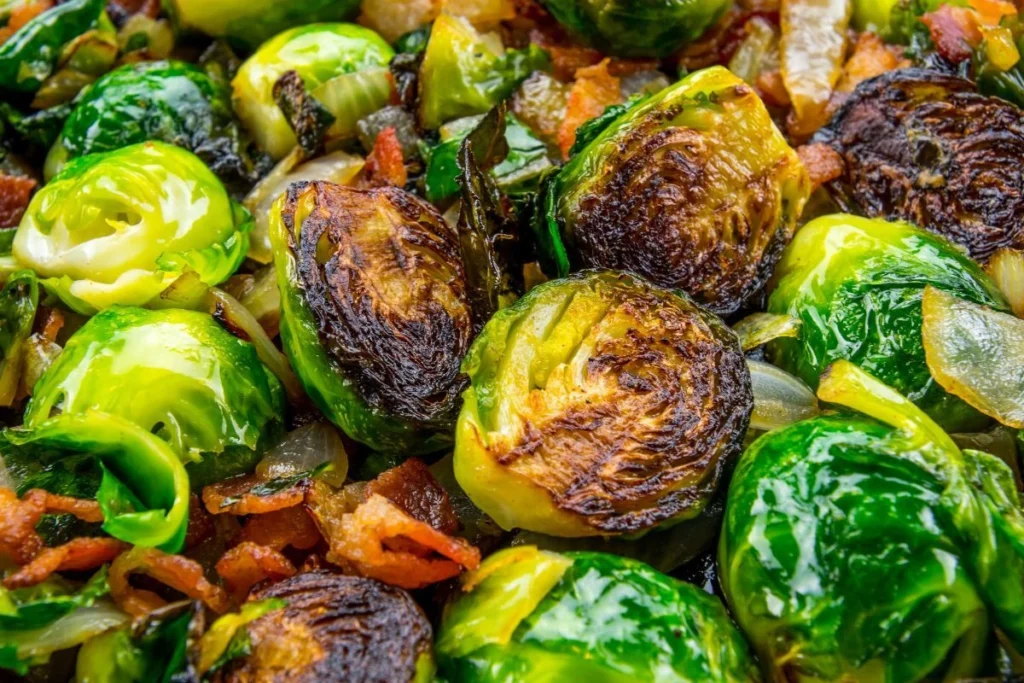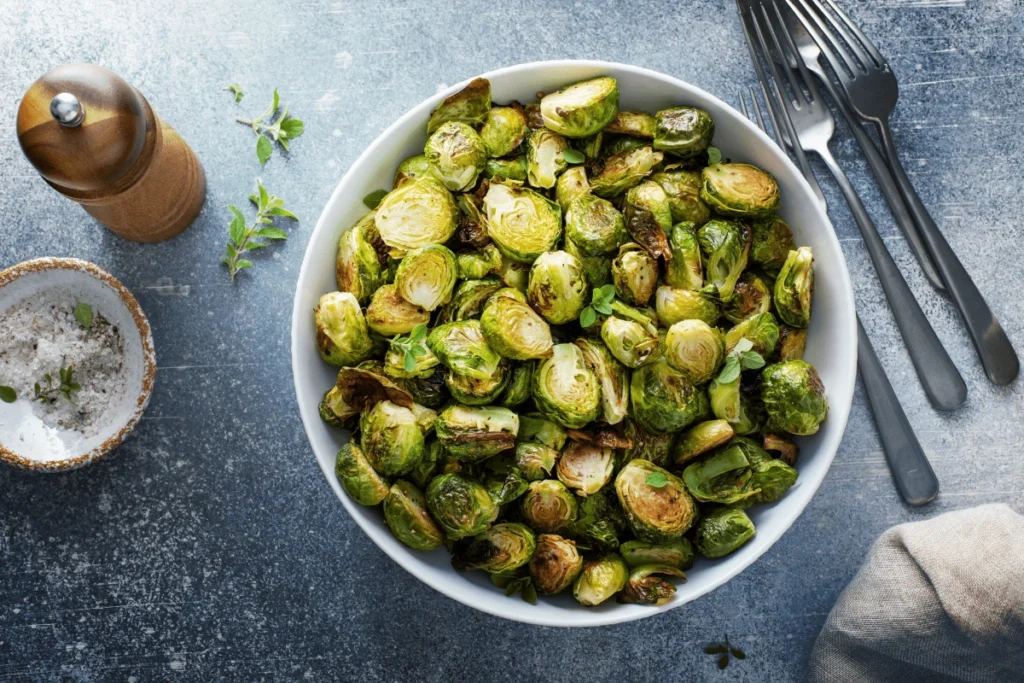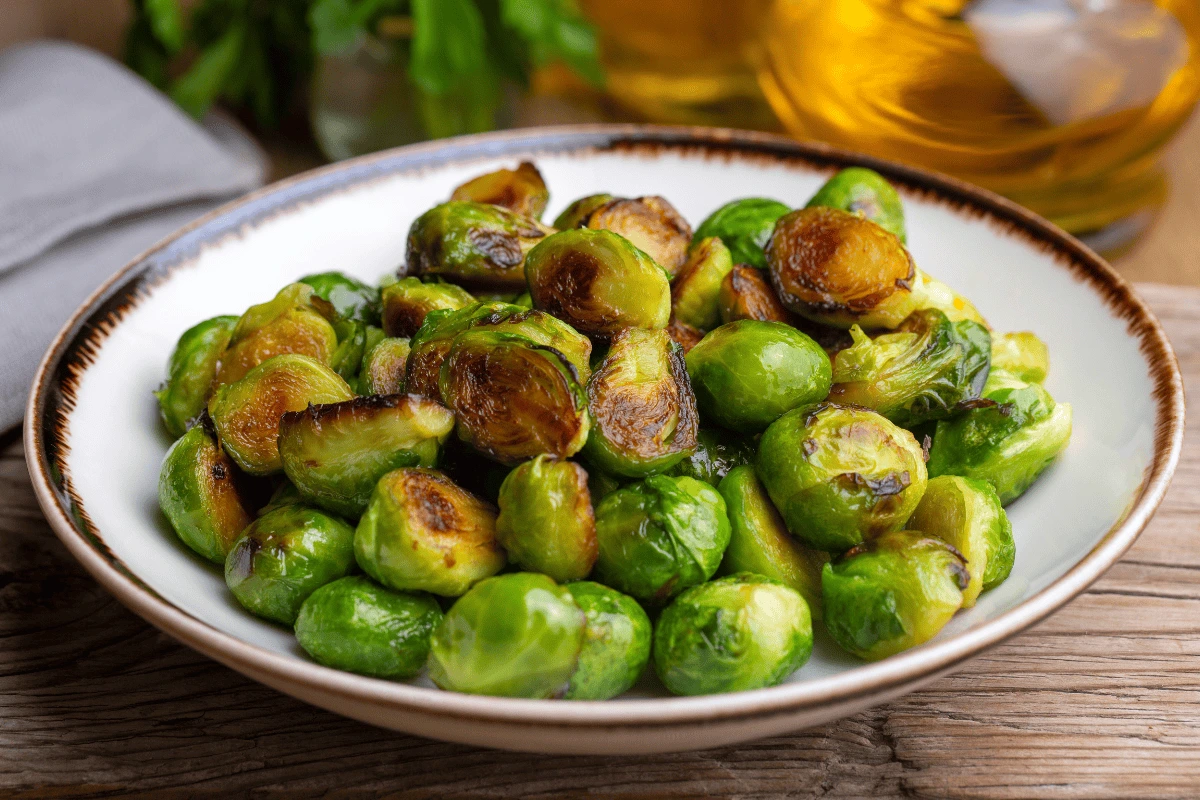If you’re looking for tips on mastering roasted Brussels sprouts, avoiding common mistakes is key to getting them just right. There’s nothing worse than pulling a pan of Brussels sprouts from the oven only to find them burnt, soggy, or stubbornly bitter. You’re not alone. For years, these tiny cabbages got a bad rap—until chefs unlocked their potential as a caramelized, tender side dish that even skeptics crave
When it comes to mastering roasted Brussels sprouts, the key is to get the perfect balance of crispy, tender texture. You can drizzle them with sweet and savory glazes or sprinkle lemon zest and herbs for brightness. Yet, too often, small oversights turn this veggie into a disappointment. Let’s fix that.
Key Takeaways
- Avoid overcrowding the pan to ensure even browning.
- Use the right oil quantity for crispness without greasiness.
- Cut sprouts consistently for uniform cooking.
- Stick to the ideal oven temperature range.
- Flip sprouts halfway to prevent burning.
These seven mistakes stand between you and Brussels sprouts that shine as a star side—whether you’re pairing them with pork, chicken, or even a simple sprinkle of lemon zest and herbs. Let’s break down what to fix first.
Avoid Overcrowding: A Key to Mastering Roasted Brussels Sprouts
Ever tried roasting Brussels sprouts and ended up with soggy, unevenly cooked veggies? Overcrowding your pan stops air from circulating. This turns your dish into a steam bath instead of a crispy, caramelized treat. Here’s how to fix it.
Why Brussels Sprouts Need Their Space
Air circulation is key. When Brussels sprouts are packed too close, their released moisture can’t evaporate. This traps steam, leaving sprouts soggy. Proper spacing ensures each sprout touches the pan surface to brown evenly.
Pro tip: Use parchment paper for easy flipping without losing space.
Determining the Right Amount of Sprouts Per Pan
Stick to one layer. Here’s how much fits:
| Pan Size | Brussels Sprouts | Garlic Cloves |
|---|---|---|
| 13×18-inch half sheet | 1 ½ lbs (24-30 sprouts) | 8-10 cloves |
| 16×20-inch full sheet | 2-2.5 lbs (35-40 sprouts) | 12-14 cloves |
Leave 1-inch gaps between every sprout and garlic. Crowding leads to pale, chewy results.
Sheet Pan Recommendations for Perfect Roasting
Choose pans with low rims, like All-Clad Procelain or Nordic Ware Aluminum. Their design prevents steam buildup. For garlic brussels sprouts combos, stagger sprouts around minced garlic to avoid clumping.

Why Oil Quantity Matters for Mastering Roasted Brussels Sprouts
Oil is more than just a cooking aid. It’s crucial for the texture and flavor of your Brussels sprouts. Too little oil can make sprouts soft instead of crispy. The right amount helps them caramelize, giving you that golden-brown look you want.
- Use 1-2 tablespoons of oil per pound of sprouts for optimal results.
- Choose high-smoke-point oils like avocado, grapeseed, or regular olive oil.
Proper oil coating is important for seasonings to stick. When making parmesan brussels sprouts, oil helps cheese melt evenly. For a honey balsamic glaze, oil balances moisture so flavors stay without making them soggy. Make sure to toss sprouts well to coat every piece.
Adjust the oil based on sprout size. Larger sprouts might need a bit more. Skipping this step can lead to uneven cooking or blandness. Learning how to use oil right can turn ordinary Brussels sprouts into a crispy, savory side dish that everyone will enjoy.
Mastering Roasted Brussels Sprouts: Avoid Cutting Mistakes
Perfectly roasted Brussels sprouts need precise cutting to cook evenly and absorb flavors. Mistakes can make parts raw or burnt, ruining the balance of bacon and maple syrup. Here are some tips to improve your knife skills and make every bite better.
Halving vs. Quartering: When to Use Each Method
- Halve medium sprouts (1-2 inches) for quick caramelization. This method ensures the outer leaves crisp while the core stays tender, perfect for drizzling with maple syrup or tossing with crumbled bacon.
- Quarter large sprouts to shorten cooking time. Smaller pieces cook evenly, allowing bacon fat to coat each piece and maple glaze to cling better.
The Core’s Role in Even Cooking
Leaving the core intact prevents the sprouts from falling apart. The core acts as a natural anchor, ensuring every bite holds together when mixed with crispy bacon bits or glazed with maple syrup. Over-chopping risks losing the structural integrity needed for balanced flavor distribution.
Uniform Sizing for Consistency
Use this guide to match size to technique:
| Size | Cutting Method | Pairing Tips |
|---|---|---|
| Small | Whole (trim stem) | Top with bacon lardons and a light maple drizzle. |
| Medium | Halved | Cook until caramelized, then toss with maple-bacon glaze. |
| Larger | Quartered | Pair with crumbled bacon and a thick maple syrup reduction. |
Uniform pieces ensure every sprout reaches perfection, whether paired with smoky bacon or sticky maple flavors.
Mastering Roasted Brussels Sprouts: Finding the Sweet Spot for Oven Temperature
Perfect roasted Brussels sprouts need the right oven temperature. The perfect heat makes them crispy but not burnt or mushy.
Why 400-425°F Is the Ideal Range for Brussels Sprouts
At 400–425°F, Brussels sprouts get a golden crust and rich flavor through the Maillard reaction. Cooking them lower than 400°F makes them soft. Cooking them higher than 425°F can char the outside before they’re fully cooked.
This temperature range is perfect for caramelizing and cooking evenly.
- 400°F: Best for spicy Brussels sprouts with harissa seasoning to prevent spice bitterness.
- 425°F: Ideal for smaller sprouts to achieve quick browning.
Adjusting Temperature Based on Sprout Size
| Sprout Size | Temperature | Cook Time |
|---|---|---|
| Small (1-1.5 inches) | 425°F | 18-20 minutes |
| Large (2+ inches) | 400°F | 25-30 minutes |
When using harissa seasoning, reduce heat to 400°F to keep its smoky heat. Cooking over 425°F can burn the spices, hiding their flavor. Always toss sprouts halfway through cooking to ensure even seasoning.
Achieving the Perfect Balance of Crispiness and Tenderness: How to Avoid Soggy or Burnt Results
Timing is key for perfect roasted Brussels sprouts. If you overcook them, they burn. If you undercook, they stay soggy. Follow these steps for a golden outside and soft inside.
- Check sprouts at the minimum cooking time. Flip halfway to prevent burning.
- Use a light-colored baking sheet—dark pans trap heat, causing uneven browning.
- Watch moisture-heavy recipes like soy-ginger brussels sprouts; reduce time by 5-7 minutes to avoid sogginess.
- For mediterranean flavors (olive oil, lemon, herbs), stir every 8 minutes to prevent sticking and burn spots.
Moisture in marinades like soy-ginger adds flavor but shortens ideal cooking time. Reduce heat to 400°F and check after 18 minutes. Mediterranean flavors with citrus juices need constant watch—lemon zest caramelizes faster than oil alone. Use a fork to test tenderness: a gentle press should meet slight resistance, not crunch or squish.
Overcrowding or residual moisture traps steam, leading to mushiness. If using a glaze, brush it on in the last 5 minutes to preserve crispness. Trust your eyes and touch—golden edges and tender florets mean perfection.

Mastering Roasted Brussels Sprouts: The Art of Flipping During Roasting
Flipping Brussels sprouts is more than just a step—it’s a science. It’s about timing and technique. These skills turn simple sprouts into caramelized treasures. Here’s how to nail it.
Identifying the Perfect Moment to Turn Your Sprouts
Flip them when the underside is golden-brown, usually after 10–15 minutes. Look for edges that are browning but not burnt. Waiting too long can overcook one side. Flipping too soon can stop caramelization, leaving flavors flat.
- Check for golden-brown edges before flipping.
- Avoid flipping until surfaces show color to boost sweet and savory depth.
Techniques for Flipping Without Breaking
Be gentle to avoid breaking sprouts. Use a wide spatula for halved sprouts or tongs for whole ones. For smaller pieces, tilt the skillet and shake it gently. This patience ensures sprouts stay whole and cook evenly.
- Slide a spatula under sprouts to lift and turn.
- Use tongs to rotate halves without crushing.
- Shake the pan to redistribute pieces for uniform contact.
How Proper Turning Affects Caramelization
Flipping exposes all surfaces to heat, starting the Maillard reaction. This reaction deepens natural sugars into sweet notes and boosts savory umami. Balanced caramelization prevents bitter edges, making each bite sweet and savory perfection.
Elevating Your Brussels Sprouts Game Beyond Basic Mistakes
Seasoning is key to making roasted Brussels sprouts amazing. Start by sprinkling salt and pepper before roasting. This brings out their natural taste.
For garlic brussels sprouts, add 2–3 minced cloves per pound when tossing with oil. Save fresh herbs and lemon zest for after cooking. This keeps their brightness.
Adding parmesan brussels sprouts in the last 5 minutes of roasting is a game-changer. It ensures the cheese melts right and contrasts with crispy sprouts. Brush honey balsamic glaze on in the final 10 minutes to avoid burning. A 2:1 balsamic to honey ratio is perfect for even coating.
By mastering these steps, you avoid common mistakes like over seasoning. Try garlic brussels sprouts with parmesan for a delicious mix. With your roasting technique, each bite will achieve the ideal balance of crispiness and tenderness, packed with rich flavors.
Ultimately: Mastering the Art of Roasting Brussels Sprouts
By avoiding common mistakes such as overcrowding the pan, using the right amount of oil, and cutting your sprouts evenly, you can create perfectly roasted Brussels sprouts every time. With the right techniques and temperature control, you’ll achieve a crispy, tender texture and a delicious flavor that will elevate any meal. Whether you prefer them with a sweet maple glaze, savory bacon, or fresh Mediterranean herbs, mastering Brussels sprouts roasting will make them a standout side dish for any occasion.
FAQ
What is the best way to season Brussels sprouts for optimal flavor?
To make Brussels sprouts taste great, start with salt and pepper before roasting. Then, add herbs, lemon zest, or finishing touches after they’re cooked. For a garlic flavor, use 2-3 cloves per pound for a deep taste.
How can I achieve crispy Brussels sprouts without burning them?
To get crispy sprouts without burning, roast at 400-425°F. Watch them closely to determine when they’re fully cooked. Turning them halfway helps them cook evenly and prevents burning.
What is the ideal oven temperature for roasting Brussels sprouts?
The best oven temperature is 400-425°F. This helps them get crispy on the outside and tender inside without burning.
How can I avoid overcrowding my roasting pan?
Make sure Brussels sprouts don’t touch each other on the pan. Use a half-sheet pan for better air circulation. This helps them roast evenly.
What cutting techniques yield the best texture in roasted Brussels sprouts?
To ensure even cooking, slice medium sprouts in half and cut larger ones into quarters. Roast small sprouts whole. Keeping the core helps them stay in shape.
Can I use oil for flavor, or is it just for cooking?
Oil is key for both cooking and flavor. It helps them get crispy and seasonings stick. Use 1-2 tablespoons of oil like avocado or grapeseed per pound for the best taste.
How do I make spicy Brussels sprouts?
To make spicy sprouts, use harissa seasoning. But watch the oven temperature to avoid bitter flavors. Aim for the right temperature and adjust for sprout size.
What are some popular flavor pairings for Brussels sprouts?
Popular pairings include honey balsamic glaze for sweetness, bacon and maple syrup for richness, and Mediterranean flavors with olive oil, lemon, and herbs for a fresh twist.
Can I prepare Brussels sprouts ahead of time?
Yes, you can trim and season sprouts ahead. But roast them just before serving. Pre-roasting can make them soggy and lose crispiness.
Mastering Roasted Brussels Sprouts: 7 Mistakes to Avoid
Equipment
- Baking Sheet
- Mixing Bowl
- Spatula or Tongs
Ingredients
Basic Roasted Brussels Sprouts
- 1 lb Brussels sprouts trimmed and halved
- 2 tbsp olive oil
- 1 tsp sea salt
- 1/2 tsp black pepper
Instructions
- Preheat the oven to 400°F (200°C).
- Ensure Brussels sprouts are completely dry before roasting to prevent sogginess.
- In a mixing bowl, toss Brussels sprouts with olive oil, salt, and black pepper until evenly coated.
- Spread the Brussels sprouts on a baking sheet in a single layer, leaving space between each piece.
- Roast for 20-25 minutes, flipping halfway through to ensure even browning.
- Check for golden-brown edges and tender insides before removing from oven.
- Serve immediately with optional seasonings like lemon zest, Parmesan, or balsamic glaze.

